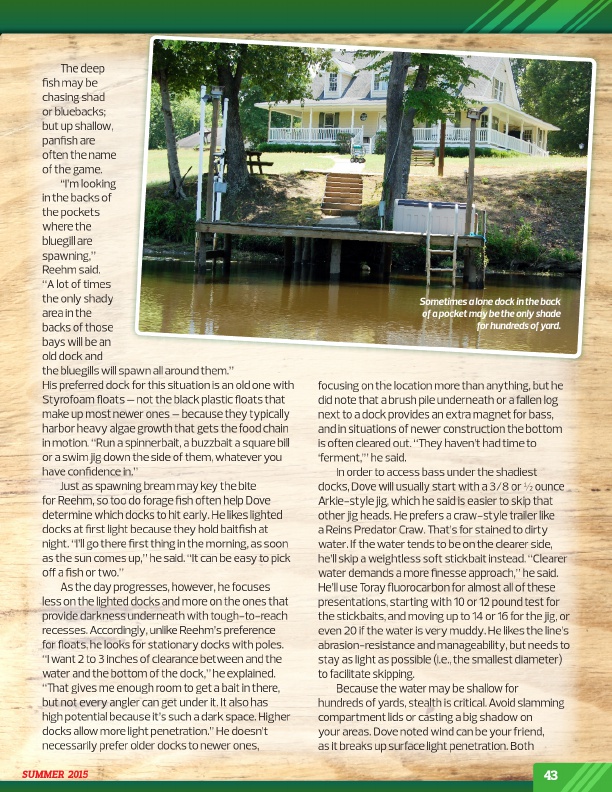
The deep fish may be chasing shad or bluebacks; but up shallow, panfish are often the name of the game.
“I’m looking in the backs of the pockets where the bluegill are spawning,” Reehm said. “A lot of times the only shady area in the backs of those bays will be an old dock and the bluegills will spawn all around them.” His preferred dock for this situation is an old one with Styrofoam floats – not the black plastic floats that make up most newer ones – because they typically harbor heavy algae growth that gets the food chain in motion. “Run a spinnerbait, a buzzbait a square bill or a swim jig down the side of them, whatever you have confidence in.”
Just as spawning bream may key the bite for Reehm, so too do forage fish often help Dove determine which docks to hit early. He likes lighted docks at first light because they hold baitfish at night. “I’ll go there first thing in the morning, as soon as the sun comes up,” he said. “It can be easy to pick off a fish or two.”
As the day progresses, however, he focuses less on the lighted docks and more on the ones that provide darkness underneath with tough-to-reach recesses. Accordingly, unlike Reehm’s preference for floats, he looks for stationary docks with poles. “I want 2 to 3 inches of clearance between and the water and the bottom of the dock,” he explained. “That gives me enough room to get a bait in there, but not every angler can get under it. It also has high potential because it’s such a dark space. Higher docks allow more light penetration.” He doesn’t necessarily prefer older docks to newer ones,
SUMMER 2015
Sometimes a lone dock in the back of a pocket may be the only shade
for hundreds of yard.
focusing on the location more than anything, but he did note that a brush pile underneath or a fallen log next to a dock provides an extra magnet for bass, and in situations of newer construction the bottom is often cleared out. “They haven’t had time to ‘ferment,’” he said.
In order to access bass under the shadiest docks, Dove will usually start with a 3/8 or ½ ounce Arkie-style jig, which he said is easier to skip that other jig heads. He prefers a craw-style trailer like a Reins Predator Craw. That’s for stained to dirty water. If the water tends to be on the clearer side, he’ll skip a weightless soft stickbait instead. “Clearer water demands a more finesse approach,” he said. He’ll use Toray fluorocarbon for almost all of these presentations, starting with 10 or 12 pound test for the stickbaits, and moving up to 14 or 16 for the jig, or even 20 if the water is very muddy. He likes the line’s abrasion-resistance and manageability, but needs to stay as light as possible (i.e., the smallest diameter) to facilitate skipping.
Because the water may be shallow for hundreds of yards, stealth is critical. Avoid slamming compartment lids or casting a big shadow on your areas. Dove noted wind can be your friend, as it breaks up surface light penetration. Both
43